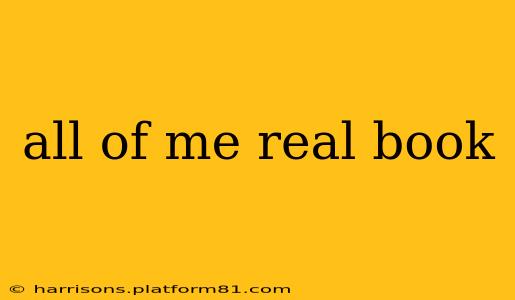"All of Me" is a timeless jazz standard, a staple in countless Real Books and the repertoire of virtually every seasoned jazz musician. Its simple, yet profoundly expressive melody and chord progression have made it a vehicle for countless improvisational explorations. This enduring popularity begs the question: what makes "All of Me" so captivating, and why does it continue to resonate with musicians and listeners alike? Let's delve into the history, structure, and enduring appeal of this jazz masterpiece.
Who Wrote "All of Me"?
The song's origins lie with Gerald Marks (music) and Seymour Simons (lyrics), who composed it in 1930. Interestingly, while the song is most commonly associated with jazz, its initial popularity stemmed from its adoption within the popular music scene of the time. Many early recordings showcase its versatility, demonstrating its adaptability to various musical styles beyond jazz improvisation.
What Makes "All of Me" Such a Popular Jazz Standard?
Several factors contribute to the song's enduring popularity within the jazz world:
-
Simple yet Sophisticated Harmony: The chord progression is deceptively simple, accessible to musicians of various skill levels. However, this simplicity allows for remarkable harmonic exploration and improvisation. The underlying structure opens doors to intricate melodic and rhythmic variations.
-
Evocative Melody: The melody itself is exquisitely melancholic and romantic, instantly recognizable and deeply affecting. This lyrical quality creates an emotional framework that musicians can build upon, adding their own personal interpretation and expressiveness.
-
Versatility: "All of Me" can be interpreted in numerous ways. It lends itself to both introspective ballads and energetic, upbeat tempos. This flexibility makes it a perfect vehicle for showcasing a musician's range and style.
-
Its Place in the Real Book: The Real Book's inclusion cemented the song's status as a jazz standard. Its widespread availability made it accessible to countless musicians, accelerating its adoption and ensuring its continued relevance.
What are the Common Chords Used in "All of Me"?
The song primarily uses a straightforward ii-V-I progression in the key of C major (Dm7-G7-CM7). However, sophisticated variations and alterations are commonly employed during improvisations, adding depth and complexity to the harmonic structure. Musicians often explore substitutions, extensions, and alterations, resulting in a rich tapestry of sounds and textures.
How Do Jazz Musicians Typically Improvise Over "All of Me"?
Improvisation over "All of Me" usually centers around the ii-V-I progression. Musicians will often target the dominant seventh chords (G7 in the standard key of C major) for strong melodic and harmonic resolutions. The rich harmonic landscape offers ample opportunity for chromaticism, altered dominant chords, and modal interchange, providing endless possibilities for creative improvisation.
What are Some Famous Recordings of "All of Me"?
Countless artists have recorded "All of Me" over the years, each offering a unique interpretation. While an exhaustive list is impossible, many renowned versions exist, spanning various eras and styles, demonstrating the song's enduring appeal and adaptability. Discovering these varied renditions can offer valuable insights into the song's compositional strength and the creative freedom it affords musicians.
Conclusion: The Enduring Legacy of "All of Me"
"All of Me" remains a cornerstone of the jazz repertoire for good reason. Its elegant melody, accessible yet versatile harmonic structure, and enduring emotional resonance continue to inspire musicians and listeners alike. Its presence in the Real Book only solidified its status as a timeless classic, guaranteeing its continued relevance for generations to come. The song's enduring appeal underscores its remarkable power to connect with audiences on a deeply emotional level, making it a true masterpiece of the American songbook.
